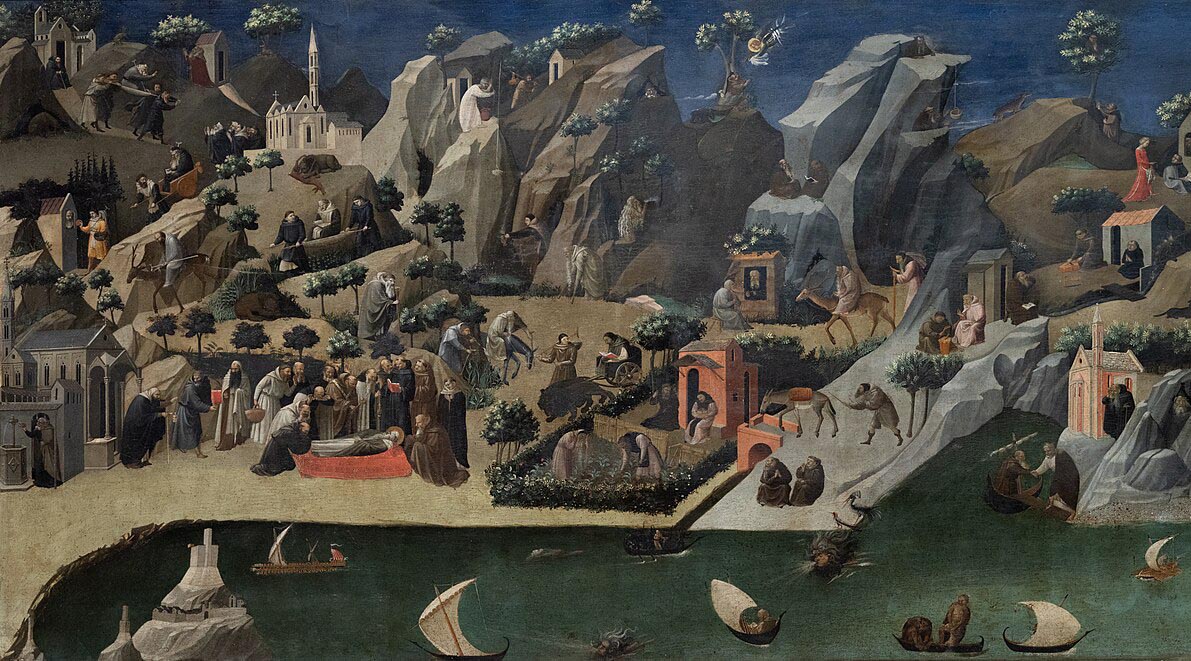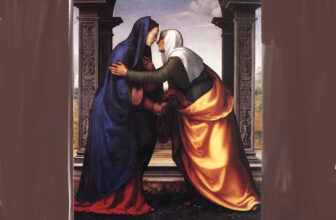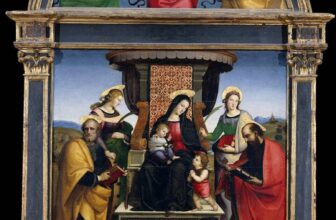
What Is Fra Angelico Known For
In the quiet cloisters of a Dominican monastery in 15th-century Florence, a man knelt in prayer before he painted. His name was Fra Giovanni da Fiesole, though the world would come to know him as Fra Angelico, “the Angelic Brother.” To his contemporaries, he was not merely an artist but a holy man whose paintings were considered divine sermons in color and form. As Giorgio Vasari wrote, “It is impossible to bestow too much praise on this holy father, who was so humble and modest… and who painted with such grace and piety.”
Fra Angelico is one of the greatest figures in early Renaissance art. His works do more than represent religious themes, they elevate them into spiritual experiences. With a palette blessed by serenity and light, his brush captured sacred truths that transcended the visual to touch the soul. This is his story.
The Life and Calling of Fra Angelico
Fra Angelico was born as Guido di Pietro around 1395 in the Tuscan town of Vicchio, not far from Florence. Little is known about his early life, but it is believed he trained as an illuminator of manuscripts before becoming a painter. In the early 1420s, Guido joined the Dominican Order at the convent of San Domenico in Fiesole and took the religious name Fra Giovanni. His deep piety and spiritual devotion would infuse every brushstroke of his artistic life.
He never signed his paintings, a reflection of his humility. For Fra Angelico, painting was not an act of self-expression or fame, it was an act of worship. Before beginning any work, he would pray, asking for divine guidance. It is no wonder that later generations called him Fra Angelico, the Angelic Brother. In 1982, Pope John Paul II beatified him, recognizing both his spiritual and artistic legacy.
Fra Angelico is best known for his pioneering work at the dawn of the Italian Renaissance, his unique fusion of medieval spirituality with Renaissance naturalism, and his masterful use of color, light, and perspective. He specialized in religious art, Altarpieces, frescoes, and devotional paintings that conveyed complex theological ideas with clarity and emotional resonance.
His artistic hallmarks include:
Graceful, elongated figures that seem to float in divine serenity.
Brilliant yet soft colors, often imbued with symbolic meaning.
Intricate gold detailing, reminiscent of manuscript illumination.
Expressive, soulful faces that evoke deep emotion and contemplation.
Atmospheric light, conveying the divine presence.
He was not just a craftsman but a theologian with a brush. His work aimed to instruct, inspire, and uplift.
Fra Angelico’s Most Famous Paintings
Over his prolific career, Fra Angelico created dozens of major works. While exact counts vary, art historians estimate that more than 135 paintings and frescoes are attributed to him, either wholly or in part. Some were collaborative efforts with assistants or followers from his workshop. Among these, several stand as timeless masterpieces of religious art.
1. The Annunciation (1437–1446), Convent of San Marco, Florence
Perhaps the most iconic of all his works, the Annunciation fresco at the top of the stairs in the Convent of San Marco is a breathtaking portrayal of the angel Gabriel announcing to Mary that she will bear the Christ child.
Painted in soft, ethereal tones, the scene glows with serenity. Gabriel’s wings shimmer, and Mary sits in humble acceptance. The architectural setting reflects Brunelleschian design, creating a peaceful harmony between space and figures. It’s a perfect visual meditation, made not for public display but for the contemplation of Dominican friars.
2. The San Marco Altarpiece (1438–1443)
This altarpiece, located in the Museum of San Marco, is a rich and detailed portrayal of the Madonna and Child with Saints. Its composition, color, and theological precision mark it as one of the greatest achievements of Renaissance panel painting. The golden background hearkens to medieval iconography, while the naturalistic faces and detailed drapery show Renaissance influence.
3. The Last Judgment (1447–1449), Orvieto Cathedral
Fra Angelico collaborated with Benozzo Gozzoli on this dramatic fresco cycle in the Chapel of San Brizio in Orvieto Cathedral. His vision of the Last Judgment is simultaneously terrifying and beautiful, filled with angels, saints, the blessed, and the damned. It is a profound meditation on divine justice and mercy.
4. The Deposition (1432–1434), Museo di San Marco
This poignant image of Christ being taken down from the cross features the Virgin Mary, John the Evangelist, and Mary Magdalene. The composition emphasizes grief without despair. It is a silent scream, a holy lament. Located in Florence’s Museo di San Marco, the painting’s balance of color and form places it among Fra Angelico’s most emotionally powerful works.
5. The Coronation of the Virgin (c. 1434–1435), Uffizi Gallery
A luminous altarpiece, this work depicts the Virgin being crowned by Christ amidst a celestial host of angels and saints. The detailed gold leaf work and vibrant colors celebrate heavenly glory. It is a visual symphony of divine joy and reverence.
What Is the Most Expensive Painting by Fra Angelico?
The most expensive painting by Fra Angelico ever sold at auction is “The Virgin of the Pomegranate”, a work that was once attributed to Fra Angelico’s workshop but is now considered to have been at least partially painted by his hand.
In January 2001, “The Virgin and Child with Two Angels” (also known as the Cortona Madonna) was auctioned at Christie’s in New York for $4.6 million. However, private sales and museum acquisitions may involve much higher, undisclosed figures, especially for verified standalone works.
Most of Fra Angelico’s greatest masterpieces are in public or religious collections and are considered national treasures, effectively priceless and unlikely ever to be sold.
Where Are Fra Angelico’s Paintings Located Today?
Fra Angelico’s works are spread across Europe and North America, but the heart of his legacy resides in Italy. Here are some major locations where his art can be found:
Florence, Italy
Museo di San Marco – Houses the greatest concentration of his work, including The Annunciation, Crucifixion, Deposition, and dozens of frescoes painted in monks’ cells.
Uffizi Gallery – Holds works like The Coronation of the Virgin and The Madonna of Humility.
Museo del Convento di San Domenico, Fiesole – Features early altarpieces and panel paintings.
Rome, Italy
Vatican Museums – Fra Angelico painted the Niccoline Chapel in the Apostolic Palace for Pope Nicholas V, with frescoes depicting St. Lawrence and St. Stephen.
Galleria Nazionale d’Arte Antica – Home to smaller works and devotional panels.
Paris, France
Louvre Museum – Hosts a few attributed panels and altarpiece fragments.
London, UK
National Gallery – Holds The San Domenico Altarpiece (1430s), a radiant example of his early style.
Madrid, Spain
Museo del Prado – Home to works from his workshop and devotional panels.
United States
Metropolitan Museum of Art (New York) – Holds several attributed works and fragments.
National Gallery of Art (Washington, D.C.) – Features altarpiece panels and predellas.
How Many Paintings Did Fra Angelico Create?
Though records from the 15th century are incomplete, art historians estimate that Fra Angelico created or contributed to between 135 and 150 works, including:
Fresco cycles (such as at San Marco and the Vatican)
Altarpieces (both large and small)
Predella panels (the small scenes at the base of altarpieces)
Individual devotional paintings
Many of these works were created with the assistance of his workshop, including his close pupil Benozzo Gozzoli, who would later become a master in his own right.
The Legacy of Fra Angelico
Fra Angelico’s legacy is twofold: artistic and spiritual. His influence on Renaissance art cannot be overstated. He bridged the sacred symbolism of medieval art with the burgeoning realism and perspective of the Renaissance, paving the way for artists like Piero della Francesca, Leonardo da Vinci, and Michelangelo.
1. A Model of Holiness
Unlike many artists of his time who pursued fame and wealth, Fra Angelico lived a life of prayer, simplicity, and humility. His beatification in 1982 by Pope John Paul II was not merely a recognition of his personal sanctity but also an acknowledgment of how art can be a path to holiness.
He is the patron of Catholic artists, and his feast day is celebrated on February 18.
2. Influence on Renaissance Art
Fra Angelico introduced a new visual language that combined:
Emotional depth
Elegant linearity
Architectural precision
Heavenly luminosity
His use of single-point perspective, while not as mathematically precise as that of Brunelleschi or Alberti, gave his compositions a more grounded realism that elevated their spiritual power.
3. A Timeless Artistic Standard
To this day, Fra Angelico is revered not only as a master of composition and color but as a beacon of what art can be at its best: a window into the divine.
A Legacy Written in Light
In an age of spectacle, Fra Angelico reminds us of the quiet power of beauty rooted in faith. His paintings do not shout, they whisper truths to the soul. They draw us not into the chaos of the world but into the peace of contemplation. His brush was not merely a tool of art, it was an instrument of prayer.
To stand before a Fra Angelico painting is to encounter more than pigment and canvas, it is to meet a man who painted with a heart turned toward heaven. His legacy endures not only in museums and monasteries but in the hearts of those who, centuries later, are still moved by the angelic light he left behind.




